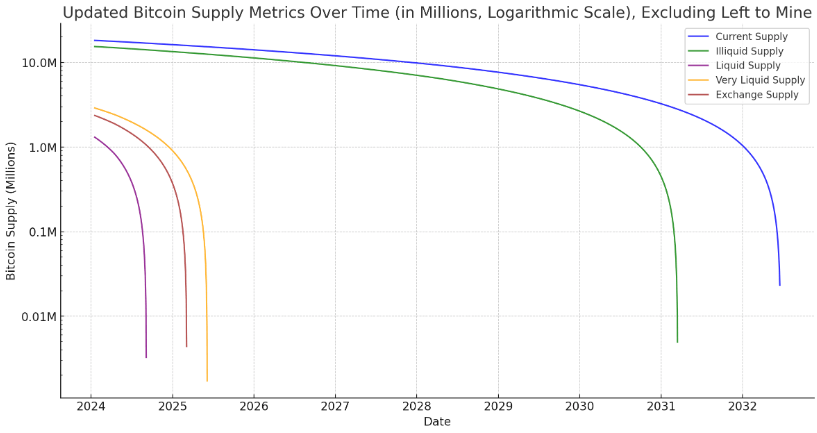Is this the Bitcoin ETF supply squeeze playing out already?

Seven days after the new Bitcoin ETFs launched, I analyzed how they could put pressure on Bitcoin’s supply dynamics in an article called “If BlackRock continues 6k BTC daily buys, we get a supply crunch within 18 months; here’s why.’ On the day of publication, Jan. 18, Bitcoin closed at $41,248 after falling from a high of $49,000 on Jan. 11. Since then, the flagship digital asset has soared 37% to break $57,000.
While Bitcoin had fallen consistently after the ETF launched, CryptoSlate noted the persistent BTC inflows, which, at the time, averaged around 6,266 BTC per day for BlackRock alone. The analysis identified that were such inflows continue, the liquid supply of Bitcoin could be absorbed this year, with the exchange balances or very liquid supplies targetable by mid-2025.

As noted at the time, the analysis was purely hypothetical and did not consider the outflows from Grayscale GBTC. Additionally, it only looked at BlackRock, the largest fund’s inflows, to simplify the data at that point. The exercise aimed to emphasize the potential for a supply squeeze and the lack of liquid Bitcoin to facilitate persistent ETF pressure on the supply. On Jan. 18, BlackRock had 25,067 BTC under management, valued at $1 billion.

Interestingly, while the inflows into BlackRock did not maintain the 6,266 BTC daily average pressure, inflows into the Newborn Nine have surpassed this level. BlackRock currently has 130,231 BTC under management, whereas the fund would have 275,707 BTC if it continued at 6,266 BTC daily. However, on Jan. 18, 6,266 BTC was valued at $258 million, which would now represent an inflow of $357 million, given the dramatic price surge.

It’s important to remember that the spot Bitcoin ETFs are purchased with dollars and denominated in dollars in a brokerage account. Thus, while inflows into the ETF have been consistent in dollar terms, they have been reduced in terms of Bitcoin purchases.
Across the Newborn Nine, 303,002 BTC is now held under management per K33 Research. Looking at the CryptoSlate table used for the Jan. 18 article, this aligns with inflows projected for BlackRock by March 2, 2024.

Using this data, should the Newborn Nine continue to absorb Grayscale’s declining outflows and purchase additional Bitcoin from the broader market at this pace, 1 million BTC could be under management by June. Further, this rate would swallow the BTC equivalent of the entire current liquid supply of Bitcoin (roughly 1.3 million BTC) by September.
On Feb. 8, I discussed the potential for the ‘Mother of all Supply Squeezes‘ for Bitcoin, which is akin to the GameStop saga but even more effective. The price has surged 29% since that article went live in just 19 days, an average of 0.65% per day. Bitcoin ETFs have continued to buy, and Grayscale’s outflows are slowing.
The requirements for a supply squeeze appear to be present; the only question I see is, at what level does the demand become affected by the price? Do Bitcoin ETF purchasers continue to buy if Bitcoin is at $100,000? Well, at that price, BlackRock’s IBIT would be around $60 per share. That doesn’t sound quite as expensive to new investors now, does it?




 Bitcoin
Bitcoin  Ethereum
Ethereum  Tether
Tether  USDC
USDC  Dogecoin
Dogecoin  TRON
TRON  Cardano
Cardano  Chainlink
Chainlink  Bitcoin Cash
Bitcoin Cash  LEO Token
LEO Token  Litecoin
Litecoin  Dai
Dai  Monero
Monero  Stellar
Stellar  Ethereum Classic
Ethereum Classic  Stacks
Stacks  OKB
OKB  Cronos
Cronos  Hedera
Hedera  Cosmos Hub
Cosmos Hub  Gate
Gate  Theta Network
Theta Network  KuCoin
KuCoin  Maker
Maker  Algorand
Algorand  Polygon
Polygon  Tether Gold
Tether Gold  NEO
NEO  EOS
EOS  Tezos
Tezos  Zcash
Zcash  TrueUSD
TrueUSD  Synthetix Network
Synthetix Network  Bitcoin Gold
Bitcoin Gold  IOTA
IOTA  Holo
Holo  Dash
Dash  Zilliqa
Zilliqa  0x Protocol
0x Protocol  Siacoin
Siacoin  Ravencoin
Ravencoin  Enjin Coin
Enjin Coin  Basic Attention
Basic Attention  Qtum
Qtum  Decred
Decred  Ontology
Ontology  NEM
NEM  Lisk
Lisk  Pax Dollar
Pax Dollar  Nano
Nano  Numeraire
Numeraire  Waves
Waves  DigiByte
DigiByte  Status
Status  Huobi
Huobi  Hive
Hive  Steem
Steem  BUSD
BUSD  Ren
Ren  OMG Network
OMG Network  Bitcoin Diamond
Bitcoin Diamond  Bytom
Bytom  Kyber Network Crystal Legacy
Kyber Network Crystal Legacy  HUSD
HUSD